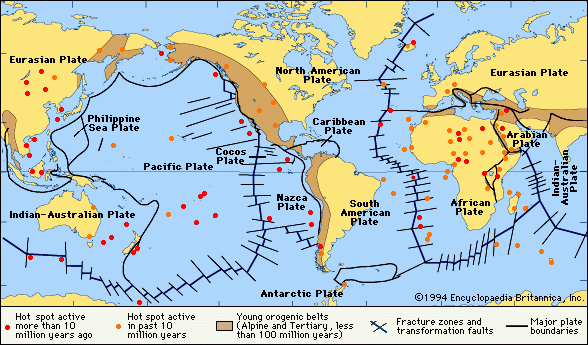Fracture zones and hot spots can be found in the litosphere, the rigid outer layer of Earth, beneath of oceans and continents.
Ain the Earth, the lithosphere includes the crust and the uppermost mantle, which constitute the hard and rigid outer layer of the Earth. The lithosphere is underlain by the asthenosphere, the weaker, hotter, and deeper part of the upper mantle. The boundary between the lithosphere and the underlying asthenosphere is defined by a difference in response to stress: the lithosphere remains rigid for very long periods of geologic time in which it deforms elastically and through brittle failure, while the asthenosphere deforms viscously and accommodates strain through plastic deformation. There are two types of lithosphere: 1) oceanic lithosphere, which is associated with oceanic crust and exists in the ocean basins, 2) continental lithosphere, which is associated with continental crust. The composition of the two types of crust differs markedly, with basaltic rocks ("mafic") dominating oceanic crust, while continental crust consists principally of lower density granitic rocks ("felsic"). The lithosphere is broken into tectonic plates. The following tectonic plates currently exist on the earth's surface with roughly definable boundaries. There are seven primary plates (African Plate, Antarctic Plate, Eurasian Plate, Indo-Australian Plate, North American Plate, Pacific Plate, South American Plate) and some secondary smaller plates (Arabian-, Caribbean-, Cocos-, Scotia-, Adria-, Aegean-, Arab-, Iranian-, Nazca-, Philippine Sea -plates).These plates are rigid segments that move in relation to one another at one of three types of plate boundaries: 1) convergent boundaries, at which two plates come together, (an example of such a boundary is the San Andreas fault in California) 2) divergent boundaries, at which two plates are pulled apart (the Atlantic Ocean was created by this process, the mid-Atlantic Ridge is an area where new sea floor is being created), and 3) transform boundaries, in which two plates slide past one another laterally. Earthquakes, volcanic activity, mountain-building, and oceanic trench formation can occur along these plate boundaries. The tectonic plates ride on top of the asthenosphere, the solid but less-viscous part of the upper mantle that can flow and move along with the plates, and their motion is strongly coupled with patterns convection inside the Earth's mantle. An example of this is the Nazca plate being subducted under the South American plate to form the Andes Mountain Chain.
You can see videos on vulcano eruptions on the following web-links:
http://www.youtube.com/watch?v=R0Zbj7S22zs&feature=related
http://www.youtube.com/watch?v=y3aqFCT87_E
http://www.youtube.com/watch?v=488BkTUsMa4&NR=1&feature=fvwp
http://www.youtube.com/watch?v=Riauw5UTnW8
http://www.youtube.com/watch?v=f1ztg0wUqKY
http://www.youtube.com/watch?v=7Ya_KmcGf9Y
www.enfo.hu
https://lexikon.mokkka.hu/
